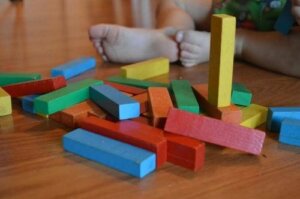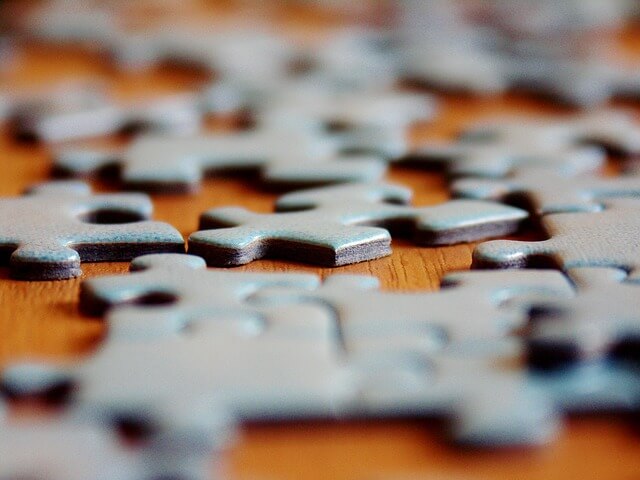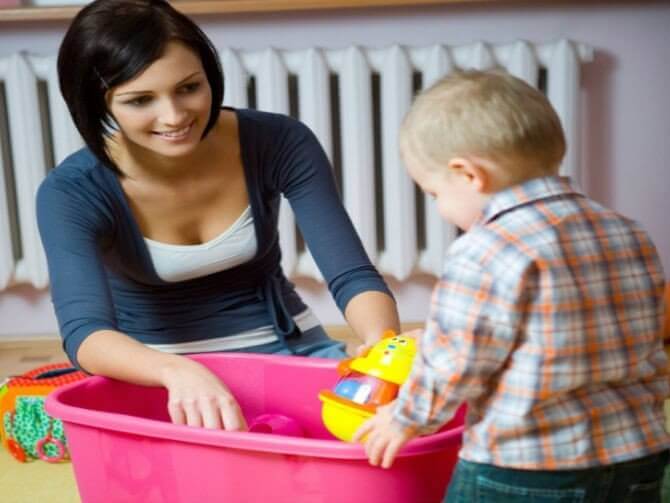Puzzles During Childhood: Educational Games for All Ages

Puzzles are educational games that are suitable for any age. However, puzzles during childhood have significant benefits. In this article, we’ll help you discover what they are. Stick around!
What are puzzles and what is their origin?
Puzzles are educational games that consist of finding an image that’s divided into multiple pieces that fit together. They’re one of the oldest and most well-known games in existence and they have multiple benefits for people of all ages.
The first puzzle was assembled for the first time in 1760, when John Spilsbury accidentally created a map of Europe by putting together different pieces. However, the game itself began in the early 19th century with artistic wooden puzzles intended for adults.
Over the years, the activity grew in popularity to such an extent that its production became widespread. Nowadays, you can find puzzles ranging from 2 to 10,000 pieces, so they’re suitable for any age.
Puzzles during childhood improve concentration, analysis, and decision making
To assemble a puzzle, your child must pay attention to the game, concentrate, analyze where each piece goes according to the image to be formed, and decide where to put each piece. Then, they’ll put the piece in its place or exchange it for the correct one.
They’ll also have to discover the best way to put the puzzle together. The goal isn’t to overwhelm them with too many pieces, but to find a way to make it easy for them to find the pieces they’re looking for.

In this task, they’ll determine whether it’s easier to start at the edges and work their way to the center, from the outside in, or from the inside out, or to put the pieces together in no particular order.
Although it seems simple, this exercise will be useful to train their mind and develop their ability to concentrate, analyze, and make decisions, as we mentioned at the beginning.
An activity that exercises children’s memory
Puzzles aren’t something that you assemble only once. When they have one in their home, children assemble and disassemble them several times until they practically learn where each piece goes by heart. In this activity, they have to memorize where the pieces go, and it’s thanks to this exercise of remembering their arrangement that they develop their memory.
They also need to remember the image they need to form, as well as the pieces that don’t fit together. Therefore, their memory, especially their visual memory, is in constant training while putting together a puzzle.
Puzzles in approaching and solving problems
Approaching and solving problems are other tasks that your child should learn to handle because, in the future, they’ll be essential for their life. Puzzles during childhood are a way to help them practice these skills. Their problem, in this case, is putting the puzzle together, and the solution is placing the pieces together one at a time until the puzzle is complete.
Problem solving in real life has the same fundamentals that are used to make a puzzle. Facing difficulties requires close observation, identifying the problem, comparing, and finding the best solution.
An activity that teaches you to try hard and not give up
Not giving up in the face of obstacles is a skill your child learns as they interact with the world. Making an effort and being persistent will help them to achieve their goals.
Puzzles during childhood will show little ones how not to give up and to continue thinking, analyzing, and deciding where to put each piece until they finish. Undoubtedly, this pastime will help them to learn to be perseverent, to make an effort, even if they feel overwhelmed, and not to let themself be defeated by difficulties.
A pastime that grants patience
If you want to calm your child’s hyperactivity, give them a jigsaw puzzle. This pastime makes them relax and take time to think. The placement of the pieces must be done carefully. Only then is it possible to fit them together. If they put the puzzle together too quickly, they’ll end up ruining the part they’ll already completed.
Puzzles also help to reduce stress. By concentrating on the game, breathing is regulated and the mind is distracted. Therefore, the more you enjoy this activity, the more you’ll relax.
Puzzles: An educational activity for any age
Jigsaw puzzles are an educational game that stimulates observation and, therefore, learning. It’s a pastime that you can share with your family, in fact, when played with others, the benefits increase, as the child learns to work as a team, to share ideas, and put into practice the suggestions of others.
Having the attention of their parents and the fact that they’re sharing one of their games with them helps kids to feel loved and valued. Completing a puzzle makes them feel proud of their work. All this improves their self-esteem.

Puzzles are a didactic game that develops logical abilities because they allow children to establish different strategies to finish the puzzle.
At the same time, puzzles develop the ability to tolerate frustration because when they make mistakes regarding the placement of different pieces, they learn not to get irritated. In addition, puzzles help them to be patient so they can concentrate better until they find the right piece.
Finally, placing the pieces in their exact place and assembling them enhances the development of fine motor skills. If your child is around 3 years old, or even younger, give them puzzles to play with, even if you have to help them.
Puzzles are educational games that are suitable for any age. However, puzzles during childhood have significant benefits. In this article, we’ll help you discover what they are. Stick around!
What are puzzles and what is their origin?
Puzzles are educational games that consist of finding an image that’s divided into multiple pieces that fit together. They’re one of the oldest and most well-known games in existence and they have multiple benefits for people of all ages.
The first puzzle was assembled for the first time in 1760, when John Spilsbury accidentally created a map of Europe by putting together different pieces. However, the game itself began in the early 19th century with artistic wooden puzzles intended for adults.
Over the years, the activity grew in popularity to such an extent that its production became widespread. Nowadays, you can find puzzles ranging from 2 to 10,000 pieces, so they’re suitable for any age.
Puzzles during childhood improve concentration, analysis, and decision making
To assemble a puzzle, your child must pay attention to the game, concentrate, analyze where each piece goes according to the image to be formed, and decide where to put each piece. Then, they’ll put the piece in its place or exchange it for the correct one.
They’ll also have to discover the best way to put the puzzle together. The goal isn’t to overwhelm them with too many pieces, but to find a way to make it easy for them to find the pieces they’re looking for.

In this task, they’ll determine whether it’s easier to start at the edges and work their way to the center, from the outside in, or from the inside out, or to put the pieces together in no particular order.
Although it seems simple, this exercise will be useful to train their mind and develop their ability to concentrate, analyze, and make decisions, as we mentioned at the beginning.
An activity that exercises children’s memory
Puzzles aren’t something that you assemble only once. When they have one in their home, children assemble and disassemble them several times until they practically learn where each piece goes by heart. In this activity, they have to memorize where the pieces go, and it’s thanks to this exercise of remembering their arrangement that they develop their memory.
They also need to remember the image they need to form, as well as the pieces that don’t fit together. Therefore, their memory, especially their visual memory, is in constant training while putting together a puzzle.
Puzzles in approaching and solving problems
Approaching and solving problems are other tasks that your child should learn to handle because, in the future, they’ll be essential for their life. Puzzles during childhood are a way to help them practice these skills. Their problem, in this case, is putting the puzzle together, and the solution is placing the pieces together one at a time until the puzzle is complete.
Problem solving in real life has the same fundamentals that are used to make a puzzle. Facing difficulties requires close observation, identifying the problem, comparing, and finding the best solution.
An activity that teaches you to try hard and not give up
Not giving up in the face of obstacles is a skill your child learns as they interact with the world. Making an effort and being persistent will help them to achieve their goals.
Puzzles during childhood will show little ones how not to give up and to continue thinking, analyzing, and deciding where to put each piece until they finish. Undoubtedly, this pastime will help them to learn to be perseverent, to make an effort, even if they feel overwhelmed, and not to let themself be defeated by difficulties.
A pastime that grants patience
If you want to calm your child’s hyperactivity, give them a jigsaw puzzle. This pastime makes them relax and take time to think. The placement of the pieces must be done carefully. Only then is it possible to fit them together. If they put the puzzle together too quickly, they’ll end up ruining the part they’ll already completed.
Puzzles also help to reduce stress. By concentrating on the game, breathing is regulated and the mind is distracted. Therefore, the more you enjoy this activity, the more you’ll relax.
Puzzles: An educational activity for any age
Jigsaw puzzles are an educational game that stimulates observation and, therefore, learning. It’s a pastime that you can share with your family, in fact, when played with others, the benefits increase, as the child learns to work as a team, to share ideas, and put into practice the suggestions of others.
Having the attention of their parents and the fact that they’re sharing one of their games with them helps kids to feel loved and valued. Completing a puzzle makes them feel proud of their work. All this improves their self-esteem.

Puzzles are a didactic game that develops logical abilities because they allow children to establish different strategies to finish the puzzle.
At the same time, puzzles develop the ability to tolerate frustration because when they make mistakes regarding the placement of different pieces, they learn not to get irritated. In addition, puzzles help them to be patient so they can concentrate better until they find the right piece.
Finally, placing the pieces in their exact place and assembling them enhances the development of fine motor skills. If your child is around 3 years old, or even younger, give them puzzles to play with, even if you have to help them.
All cited sources were thoroughly reviewed by our team to ensure their quality, reliability, currency, and validity. The bibliography of this article was considered reliable and of academic or scientific accuracy.
- Rubio Campos, E. (2019). Rompecabezas para mejorar la atención de los niños. http://repositorio.untumbes.edu.pe/handle/UNITUMBES/1474
- Alburqueque Silva, S. O. (2018). El juego de los rompecabezas como medio didáctico en educación inicial. http://repositorio.untumbes.edu.pe/handle/UNITUMBES/605
- Ligia Cristina, C. M. (2015). Los rompecabezas y su relación con el desarrollo de conflictos cognitivos en niños y niñas de primer año de la Escuela Fiscal Nicolás Aguilera parroquia Conocoto cantón Quito (Bachelor’s thesis, Universidad Tècnica de Ambato. Facultad de Ciencias Humanas y de la Educaciòn. Carrera de Parvularia). https://repositorio.uta.edu.ec/handle/123456789/13766
This text is provided for informational purposes only and does not replace consultation with a professional. If in doubt, consult your specialist.








